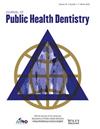Performance of atraumatic restorative treatment in primary care: A study in the elderly with home-based dental care
Abstract
Objective
To assess the performance of atraumatic restorative treatment (ART) in primary care among an elderly population in need of home-based dental care.
Methodology
It is an observational clinical study, more specifically a descriptive cohort study. The status of these restorations was evaluated1 year after placement. The analysis of ART's clinical performance was conducted through the direct clinical evaluation method, following criteria previously defined in earlier studies. Data were tabulated into sets of descriptive categories, allowing classification into a frequency distribution according to the evaluation score. Success and failure results underwent statistical evaluation using the chi-square test, with a significance level set at 5%.
Results
Elderly individuals (n = 35) participated in the study, where 103 restorations were performed in the home environment. The majority of participants were women (68.6%) with an average age of 72.3 years, and 54.3% faced difficulties in motor mobility. All received dental care exclusively at home, and 45.7% used dentures. There was a statistically significant difference (p = 0.0156) between the percentage of failures and successful cases (73.8%) without the need for ART replacement. The majority of ART interventions were on occlusal surfaces (44.9%), showing the highest percentage of restorations in good condition (84.8%), followed by mesio-occlusal (81.3%), while disto-occlusal cavities exhibited the highest failure rate (38.4%).
Conclusion
The ART demonstrates satisfactory survival rates in elderly patients after 1 year. This restoration can be a viable alternative for the treatment of older adults, especially in situations that require domiciliary dental care.

 求助内容:
求助内容: 应助结果提醒方式:
应助结果提醒方式:


